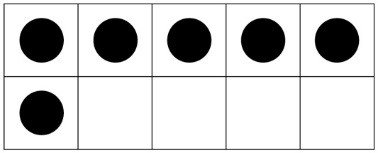The Common Core Math Check: Why different approaches are a good thing

An Ohio dad, annoyed that he couldn’t understand his kid’s math homework, demonstrated his frustration by writing a check to his child’s school using one of the methods his son was being taught, and posting a picture of it on Facebook. The dad called out “Common Core math” as the source of the problem.
The particular method this parent was unfamiliar with is actually really helpful when teaching younger kids to get a solid grasp on numbers and what addition and subtraction mean. This specific approach of drawing is one method to using base-ten to learn, and is used in addition to traditional memorization and standard techniques in classrooms across the country.
A former high school math teacher Hemant Mehta does a great job explaining to the frustrated Ohio dad what the math approach is actually doing.
“How many more dots do you need to get to ten?
You have 6. So you need 4! (And just like that, we’ve discussed addition and subtraction at the same time.)
Those are ten-frames. They’re really neat. And they’re a nice way to show little kids how to count in different ways.
“Common Core,” by the way, doesn’t even say you have to use ten-frames. For second graders, it says students should learn the base-ten system. There are all sorts of ways to teach that, whether it’s ten-frames or old-school addition. All are acceptable.”
Why does Common Core encourage multiple approaches in teaching math? As Mehta explains in his post:
“Over the past several years, what math teachers have realized is that kids who relied on memorization, algorithms, and calculators had a really hard time understanding math as they got older. Classes like algebra become scary for those kids because, all of a sudden, they couldn’t just plug things into their calculators. Variables got in the way, they had to start manipulating equations, and they just hit a wall….”
Indeed, math education today is designed to help all children, regardless of their background, develop a stronger understanding of math, so they are prepared for college-level coursework and, if they choose, advanced careers in science, technology, and engineering – all of which begin with a deep understanding of mathematics.
Different approaches resonate with different kids. For some students a visual approach to math concepts can be especially helpful.
It’s important for kids to learn multiple approaches to solving math problems so that they can choose the approach that works best for them and so that they develop a full understanding of the concepts before they move on to more challenging levels.
Want a more in depth explainer, check out this excellent video from a math teacher (and retweet to share it on twitter)!
Why does Common Core encourage kids to learn math a different way than their parents did? Watch a teacher explain: https://t.co/84Pojtcsev
— for Student Success (@StudentSuccess) September 23, 2015
Parents around the country have expressed trepidation about new math instruction they don’t recognize and rightful concern that they are unable to help their children with their homework. But, parents should want their children to be better and more confident at math than they were as students. There are many resources out there for parents to understand what kids are learning in the classroom – for example: BeALearningHero.org’s Skills Builder and Great Kids State Test Guide for Parents.
Want to take action? Add your name to this change.org pledge today to stand up for better math education for all children across America!
About the Collaborative for Student Success
At our core, we believe leaders at all levels have a role to play in ensuring success for K-12 students. From ensuring schools and teachers are equipped with the best materials to spotlighting the innovative and bold ways federal recovery dollars are being used to drive needed changes, the Collaborative for Student Success aims to inform and amplify policies making a difference for students and families.
To recover from the most disruptive event in the history of American public schools, states and districts are leveraging unprecedented resources to make sure classrooms are safe for learning, providing students and teachers with the high-quality instructional materials they deserve, and are rethinking how best to measure learning so supports are targeted where they’re needed most.



